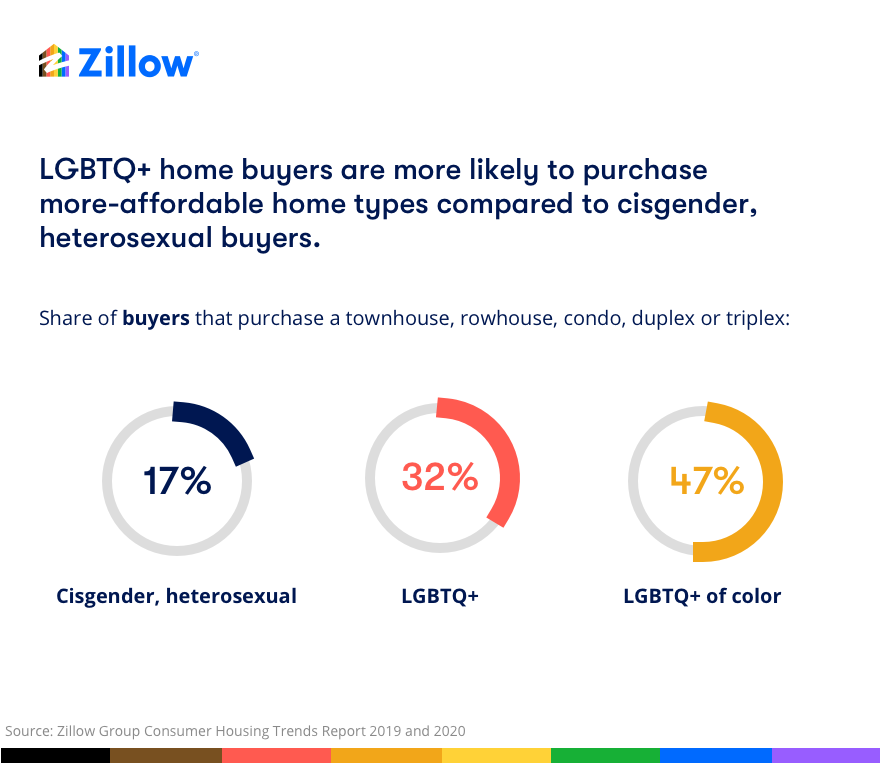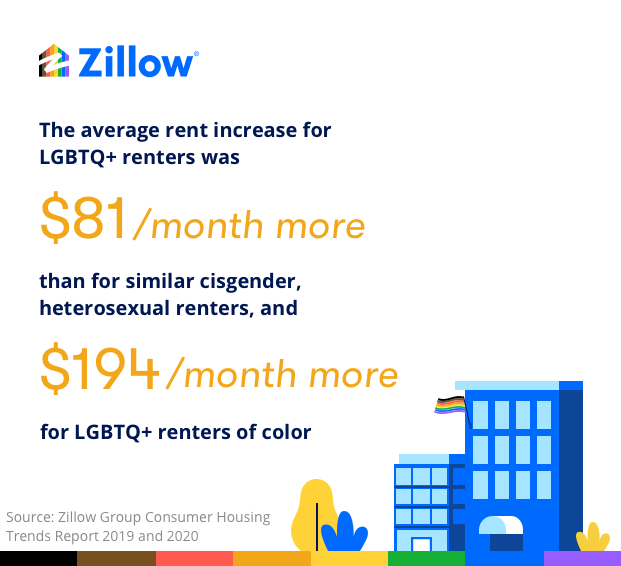LGBTQ+ Buyers & Renters Face More Challenges, Costs when Searching for a Home
Many of the housing challenges faced by LGBTQ+ households in general are even more extreme for LGBTQ+ home buyers and renters of color.

Many of the housing challenges faced by LGBTQ+ households in general are even more extreme for LGBTQ+ home buyers and renters of color.

As LGBTQ+ people fight for equal footing in the housing market, many still face disproportionate challenges compared to their cisgender, heterosexual peers — especially LGBTQ+ people who are lower-income and/or people of color, according to an analysis of data from the 2020 and 2019 Zillow Group Consumer Housing Trends Reports. These higher hurdles include more difficulty getting a mortgage, finding an affordable home and a higher likelihood of paying extra rental costs.
Previous Zillow research found that LGBT home buyers seeking a home in a state, county, or city that affords them legal protections from discrimination in housing and public accomodation can expect to pay $127,000 more than the typical home in a market with neither. This affordability challenge may in part explain why LGBTQ+ buyers gravitate towards more-affordable home types: Almost a third (32%) of LGBTQ+ buyers purchase a townhouse, rowhouse, condo, duplex or triplex, compared to less than 1 in 5 (17%) cisgender heterosexual buyers. Among LGBTQ+ home buyers of color, almost half (47%) end up purchasing these typically more-affordable home types.
But it can sometimes be difficult for buyers to find these types of homes, often because of restrictive zoning that prohibits their development and/or can make it very difficult for builders to construct this type of housing. Considering policies that can boost the availability and accessibility of these more-affordable home types could make homeownership more accessible to LGBTQ+ buyers and LGBTQ+ buyers of color.


Of course, finding a home they want to buy and can afford is only the first step — most LGBTQ+ buyers must then secure a mortgage, presenting another challenge. A third (33%) of LGBTQ+ buyers that take out a mortgage are denied at least once before ultimately getting approved, compared to 19% of cisgender heterosexual buyers with a mortgage. And again, for LGBTQ+ buyers of color the process can be even more challenging: (42%) of LGBTQ+ buyers of color are denied at least once before being approved for a mortgage.
Given these challenges, it is probably unsurprising that LGBTQ+ buyers make more sacrifices to make their deal work. More than two-thirds (70%) of LGBTQ+ buyers report making at least one sacrifice to stay at or below budget, compared to 57% of cisgender, heterosexual buyers, including buying a home that is in worse condition, lacks desired finishes and/or is smaller than initially planned. And more than three-in-four (78%) of LGBTQ+ buyers of color make at least one sacrifice, a far higher share than the 55% of white, cisgender, heterosexual buyers that report doing so.
Much like their home buying peers, LGBTQ+ renters are also more likely to face higher hurdles when trying to find a home, including withheld deposits, higher application fees and/or bigger rent increases. LGBTQ+ renters that moved from a previous rental are less likely to get their full deposit back: Only 31% of LGBTQ+ renters get their deposit back in its entirety, compared to 40% of cisgender heterosexual renters. The gap widens among racial lines: Only a quarter (25%) of LGBTQ+ renters of color got their entire deposit back, compared to closer to half (44%) of white, cisgender, heterosexual renters.
LGBTQ+ renters overall and cisgender, heterosexual renters are similarly likely to report experiencing a rent increase at their previous rental, but LGBTQ+ renters of color are significantly more likely to experience a rent hike than other groups. Almost all (90%) of LGBTQ+ renters of color who moved from a previous rental say they experienced a rent increase, compared to 76% of cisgender, heterosexual, white renters. And those rent increases are not only more frequent for LGBTQ+ renters of color, they are also more likely to be larger for the LGBTQ+ renter community overall.
Among renters who experienced a rent increase, 44% of LGBTQ+ renters overall and 46% of LGBTQ+ renters of color saw their rent go up by $200/month or more, compared to about a third (36%) of cisgender, heterosexual renters (36%). The average rent increase among all LGBTQ+ renters that experienced one was $81/month more than for cisgender, heterosexual renters. For LGBTQ+ renters of color, the average rent increase was $194/month higher than for white, cisgender, heterosexual renters whose rent went up.


And not only are monthly rent costs often higher for LGBTQ+ renters, upfront rental costs are also heftier. LGBTQ+ renters in general are more likely to pay an application fee (74% do), and LGBTQ+ renters of color even moreso (84% do), compared to 66% of cisgender, heterosexual renters. Total application fees paid by the average LGBTQ+ renter of color ($334) are more than double those paid by white, cisgender, heterosexual renters ($139).
And in the end, there is little payoff for LGBTQ+ renters to having overcome these hurdles and paid these extra costs:, LGBTQ+ renters are less likely to end up in the area in which they originally considered renting (53% vs. 59% of cisgender heterosexual renters). The divide is wider between LGBTQ+ renters of color (42%) and white, cisgender, heterosexual renters (63%). The most common reason that LGBTQ+ renters of color who didn’t end up renting in their initial area cite is that they couldn’t afford the homes for rent in that area (45%) — followed by 36% who said there weren’t many homes to rent in that area.
Despite these challenges, state and local governments can take actions to make finding home more equitable for LGBTQ+ households. Policies that legalize and/or pave the way for easier construction of lower-cost, often attached homes (many of which have been championed by LGBTQ+ lawmakers) can add more affordable inventory to markets attractive to LGBTQ+ buyers. Passage of the Equality Act would provide overt housing protections nationwide for LGBT populations; currently, 29 states and the country as a whole do not offer these kinds of legal protections for LGBT people. This Pride month, it’s critical to celebrate how far the LGBTQ+ community has come — while also recognizing how much farther there still is to go to achieve true equality.